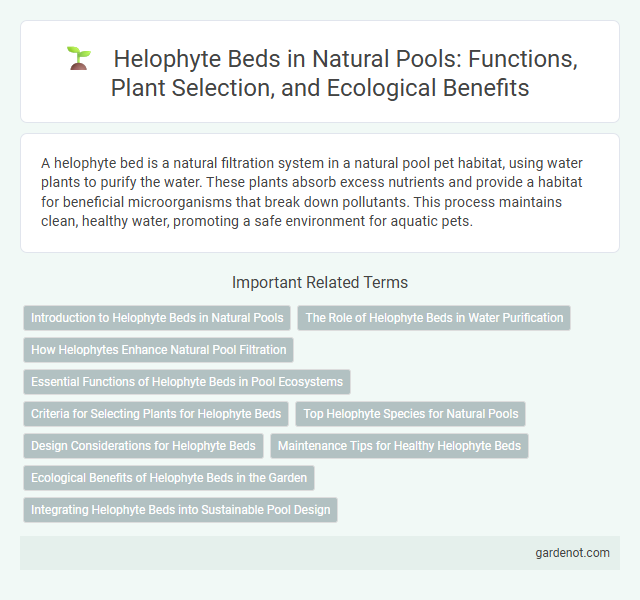A helophyte bed is a natural filtration system in a natural pool pet habitat, using water plants to purify the water. These plants absorb excess nutrients and provide a habitat for beneficial microorganisms that break down pollutants. This process maintains clean, healthy water, promoting a safe environment for aquatic pets.
Introduction to Helophyte Beds in Natural Pools
Helophyte beds in natural pools serve as biological filters, utilizing water plants rooted in gravel or sand to remove nutrients and impurities. These beds enhance water clarity and quality by promoting beneficial microbial activity within the substrate. This eco-friendly purification system supports a balanced aquatic ecosystem without the need for chemical treatments.
The Role of Helophyte Beds in Water Purification
Helophyte beds play a crucial role in natural pool water purification by filtering pollutants and enhancing water quality through biological processes. These beds use plants such as reeds and rushes whose root systems host microorganisms that break down organic matter and absorb nutrients like nitrogen and phosphorus. This natural filtration reduces algae growth and maintains the ecological balance, ensuring clear and healthy water in natural swimming pools.
How Helophytes Enhance Natural Pool Filtration
Helophyte beds play a crucial role in natural pool filtration by utilizing reed-like plants to absorb and break down organic pollutants and nutrients. Their extensive root systems create a biofilm that supports beneficial microorganisms, which decompose harmful substances and improve water clarity. This natural filtration process enhances water quality, reduces algae growth, and maintains a balanced aquatic ecosystem.
Essential Functions of Helophyte Beds in Pool Ecosystems
Helophyte beds play a critical role in natural pool ecosystems by filtering water through their root systems, effectively removing nutrients and pollutants such as nitrogen and phosphorus. These beds provide habitat for beneficial microorganisms that break down organic matter, enhancing water clarity and quality. Their dense vegetation stabilizes sediment, reduces erosion, and supports biodiversity within the aquatic environment.
Criteria for Selecting Plants for Helophyte Beds
Selecting plants for helophyte beds in natural pools requires considering factors such as root depth, tolerance to fluctuating water levels, and oxygenation capacity to ensure effective water filtration and pollutant breakdown. Species with robust root systems like common reed (Phragmites australis) and bulrush (Schoenoplectus spp.) are ideal for stabilizing substrates and supporting microbial activity. It is essential to choose native plants adapted to local climates, resistant to pests, and capable of thriving in variable hydrological conditions for sustainable ecosystem balance.
Top Helophyte Species for Natural Pools
Helophyte beds are essential for natural pool filtration, with top species like Phragmites australis, Typha latifolia, and Schoenoplectus lacustris excelling in nutrient absorption and water purification. These helophytes thrive in shallow water zones, promoting beneficial microbial activity that breaks down organic matter and reduces algae growth. Selecting native species such as Carex elata and Iris pseudacorus enhances biodiversity while maintaining optimal water clarity in eco-friendly swimming environments.
Design Considerations for Helophyte Beds
Helophyte beds require careful design to optimize water flow and support effective biofiltration in natural pools. Key considerations include selecting appropriate substrate layers, ensuring adequate depth for diverse plant root systems, and positioning plants to maximize nutrient uptake and oxygenation. Proper sizing based on pool volume and expected pollutant load is essential for maintaining water clarity and ecological balance.
Maintenance Tips for Healthy Helophyte Beds
Maintaining a healthy helophyte bed requires regular removal of dead plant material to prevent decay and excessive nutrient buildup that can lead to water quality issues in a natural pool. Periodic thinning of dense vegetation promotes better water flow and oxygenation, ensuring optimal filtration efficiency from the root systems. Monitoring water levels and adjusting irrigation helps sustain the plants' growth while preventing root rot and other moisture-related problems.
Ecological Benefits of Helophyte Beds in the Garden
Helophyte beds enhance natural pools by filtering pollutants and improving water quality through the uptake of nutrients and heavy metals. These vegetated zones create habitats for beneficial microorganisms and aquatic wildlife, promoting biodiversity within the garden ecosystem. By stabilizing sediment and reducing algae growth, helophyte beds support a balanced, self-sustaining aquatic environment.
Integrating Helophyte Beds into Sustainable Pool Design
Helophyte beds play a crucial role in sustainable natural pool design by efficiently filtering water through rooted aquatic plants, enhancing water clarity without chemicals. Integrating these biological filtration systems promotes biodiversity, supports aquatic ecosystems, and reduces the need for mechanical filtration. Properly designed helophyte beds optimize nutrient uptake and microbial activity, leading to a balanced, self-sustaining aquatic environment.
Helophyte bed Infographic

 gardenot.com
gardenot.com